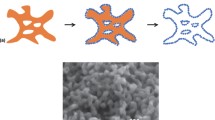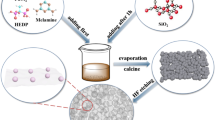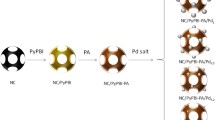Abstract
Nanoporous copper (NP-Cu), as a sacrificial support, was used for the synthesis of bimodal nanoporous palladium–copper (BNP-PdCu) for oxygen reduction reaction (ORR) electrodes in fuel cells. The catalytic performance of BNP-PdCu in ORR per electrochemical surface area was enhanced by the dissolution and removal of supporting NP-Cu, which indicates that the intrinsic catalytic properties of palladium are improved by the proposed synthesis strategy including galvanic replacement of copper with palladium, following copper dissolution. Cu remained on Pd surfaces even after dissolution of Cu. Additionally, significant local lattice contraction was observed at the ligament surface. First-principles calculations on the adsorbing oxygen species on Pd show that both lattice contraction and alloying with copper increase the binding energies of oxygen species to the Pd surface. The high ORR activity of the present BNP-PdCu is suggested to be mainly due to the Cu-ligand effect.







Similar content being viewed by others
References
I.E.L. Stephens, A.S. Bondarenko, U. Grønbjerg, J. Rossemeisl, and I. Chorkendorff: Understanding the electrocatalysis of oxygen reduction on platinum and its alloys. Energy Environ. Sci. 5, 6744–6762 (2012).
K. Wikander, H. Ekström, A.E.C. Palmqvist, and G. Lindbergh: On the influence of Pt particle size on the PEMFC cathode performance. Electrochim. Acta 52, 6848–6855 (2007).
R. Chattot, O.L. Bacq, V. Beermann, S. Kühl, J. Herranz, S. Henning, L. Kühn, T. Asset, L. Guétaz, G. Renou, J. Drnec, P. Bordet, A. Pasturel, A. Eychmüller, T.J. Schmidt, P. Strasser, L. Dubau, and F. Maillard: Surface distortion as a unifying concept and descriptor in oxygen reduction reaction electrocatalysis. Nat. Mater. 17, 827–833 (2018).
D. Jung, S. Beak, K.S. Nahm, and P. Kim: Enhancement of oxygen reduction activity by sequential impregnation of Pt and Pd on carbon support. Korean J. Chem. Eng. 27, 1689–1694 (2010).
S. Liu, X. Mu, H. Duan, C. Chen, and H. Zhang: Pd nanoparticle assemblies as efficient catalysts for the hydrogen evolution and oxygen reduction reactions. Eur. J. Inorg. Chem. 2017, 535–539 (2017).
M. Neergat, V. Gunasekar, and R. Rahul: Carbon-supported Pd–Fe electrocatalysts for oxygen reduction reaction (ORR) and their methanol tolerance. J. Electroanal. Chem. 658, 25–32 (2011).
J. Erlebacher, M.J. Aziz, A. Karma, N. Dimitrov, and K. Sieradzki: Evolution of nanoporosity in dealloying. Nature 410, 450–453 (2001).
A.J. Forty: Corrosion micromorphology of noble metal alloys and depletion gilding. Nature 282, 597–598 (1979).
D.V. Pugh, A. Dursun, and S.G. Corcoran: Formation of nanoporous platinum by selective dissolution of Cu from Cu0.75Pt0.25. J. Mater. Res. 18, 216–221 (2003).
X. Kong, C. Ma, J. Zhang, J. Sun, J. Chen, and K. Liu: Effect of leaching temperature on structure and performance of Raney Cu catalysts for hydrogenation of dimethyl oxalate. Appl. Catal., A 509, 153–160 (2016).
D.S. Keir and M.J. Pryor: The dealloying of copper-manganese alloys. J. Electrochem. Soc. 127, 2138–2144 (1980).
U-S. Min and J.C.M. Li: The microstructure and dealloying kinetics of a Cu–Mn alloy. J. Mater. Res. 9, 2878–2883 (1994).
J.R. Hayes, A.M. Hodge, J. Biener, A.V. Hamza, and K. Sieradzki: Monolithic nanoporous copper by dealloying Mn–Cu. J. Mater. Res. 21, 2611–2616 (2006).
M. Hakamada and M. Mabuchi: Preparation of nanoporous Ni and Ni–Cu by dealloying of rolled Ni–Mn and Ni–Cu–Mn alloys. J. Alloys Compd. 485, 583–587 (2009).
A. Liu, H. Geng, C. Xu, and H. Qiu: A three-dimensional hierarchical nanoporous PdCu alloy for enhanced electrocatalysis and biosensing. Anal. Chim. Acta 703, 172–178 (2011).
B. Rezaei, E. Havakeshian, and A.A. Ensafi: Fabrication of a porous Pd film on nanoporous stainless steelusing galvanic replacement as a novel electrocatalyst/electrode design for glycerol oxidation. Electrochim. Acta 136, 89–96 (2014).
J-B. Raoof, S.R. Hosseini, R. Ojani, and S. Aghajani: Fabrication of bimetallic Cu/Pd particles modified carbon nanotube paste electrode and its use towards formaldehyde electrooxidation. J. Mol. Liq. 204, 106–111 (2015).
M. Hakamada, H. Nakano, T. Furukawa, M. Takahashi, and M. Mabuchi: Hydrogen storage properties of nanoporous palladium fabricated by dealloying. J. Phys. Chem. C 114, 868–873 (2010).
C. Mahr, K. Müller-Caspary, M. Graf, A. Lackmann, T. Grieb, M. Schowalter, F.F. Krause, T. Mehrtens, A. Wittstock, J. Weissmüller, and A. Rosenauer: Measurement of local crystal lattice strain variations in dealloyed nanoporous gold. Mater. Res. Lett. 6, 84–92 (2018).
M. Hakamada, F. Hirashima, and M. Mabuchi: Catalytic decoloration of methyl orange solution by nanoporous metals. Catal. Sci. Technol. 2, 1814–1817 (2012).
M. Miyazawa, M. Hakamada, and M. Mabuchi: Antimicrobial mechanisms due to hyperpolarization induced by nanoporous Au. Sci. Rep. 8, 3870 (2018).
T. Fujita, P. Guan, K. McKeena, X.Y. Lang, A. Hirata, L. Zhang, T. Tokunaga, S. Arai, Y. Yamamoto, N. Tanaka, Y. Ishikawa, N. Asao, Y. Yamamoto, J. Erlebacher, and M.W. Chen: Atomic origins of the high catalytic activity of nanoporous gold. Nat. Mater. 11, 775–780 (2012).
M. Hakamada, Y. Sato, and M. Mabuchi: Bimodal nanoporous platinum on sacrificial nanoporous copper for catalysis of the oxygen-reduction reaction. MRS Commun. 9, 292–297 (2019).
W. Xiao, M.A.L. Cordeiro, M. Gong, L. Han, J. Wang, C. Bian, J. Zhu, H.L. Xin, and D. Wang: Optimizing the ORR activity of Pd based nanocatalysts by tuning their strain and particle size. J. Mater. Chem. A 5, 9867–9872 (2017).
R. Rahul, R.K. Singh, B. Bera, R. Devivaraprasad, and M. Neergat: The role of surface oxygenated-species and adsorbed hydrogen in the oxygen reduction reaction (ORR) mechanism and product selectivity on Pd-based catalysts in acid media. Phys. Chem. Chem. Phys. 17, 15146–15155 (2015).
Y.H. Xue, L. Zhang, W.J. Zhou, and S.H. Chan: Pd nanoparticles supported on PDDA-functionalized carbon black with enhanced ORR activity in alkaline medium. Int. J. Hydrogen Energy 39, 8449–8456 (2014).
M. Wang, X. Qin, K. Jiang, Y. Dong, M. Shao, and W-B. Cai: Electrocatalytic activities of oxygen reduction reaction on Pd/C and Pd–B/C catalysts. J. Phys. Chem. C 121, 3416–3423 (2017).
D. Park, M.S. Ahmed, and S. Jeon: Covalent functionalization of graphene with 1,5-diaminonaphthalene and ultrasmall palladium nanoparticles for electrocatalytic oxygen reduction. Int. J. Hydrogen Energy 42, 2061–2070 (2017).
S. Salomé, A.M. Ferraria, A.M. Botelho do Rego, F. Alcaide, O. Savadogo, and R. Rego: Enhanced activity and durability of novel activated carbon-supported PdSn heat-treated cathode catalyst for polymer electrolyte fuel cells. Electrochim. Acta 192, 268–282 (2016).
Y. Holade, C. Canaff, S. Poulin, T.W. Napporn, K. Servat, and K.B. Kokoh: High impact of the reducing agent on palladium nanomaterials: New insights from X-ray photoelectron spectroscopy and oxygen reduction reaction. RSC Adv. 6, 12627–12637 (2016).
J. Begum, M.S. Ahmed, S. Cho, and S. Jeon: Freestanding palladium nanonetworks electrocatalyst for oxygen reduction reaction in fuel cells. Int. J. Hydrogen Energy 43, 229–238 (2018).
P. Strasser, S. Koh, T. Anniyev, J. Greeley, K. More, G. Yu, Z. Liu, S. Kaya, D. Nordlund, H. Ogasawara, M.F. Toney, and A. Nilsson: Lattice-strain control of the activity in dealloyed core-shell fuel cell catalysts. Nat. Chem. 2, 454–460 (2010).
F.M.F. Rhen and C. McKeown: Enhanced methanol oxidation on strained Pt films. J. Phys. Chem. C 121, 2556–2562 (2017).
H.A. Gasteiger, S.S. Kocha, B. Sompalli, and F.T. Wagner: Activity benchmarks and requirements for Pt, Pt-alloy, and non-Pt oxygen reduction catalysts for PEMFCs. Appl. Catal., B 56, 9–35 (2005).
G. Jiang, H. Zhu, X. Zhang, B. Shen, L. Wu, S. Zhang, G. Lu, Z. Wu, and S. Sun: Core/shell face-centered tetragonal FePd/Pd nanoparticles as an efficient non-Pt catalyst for the oxygen reduction reaction. ACS Nano 9, 11014–11022 (2015).
H. Zhang, Q. Hao, H. Geng, and C. Xu: Nanoporous PdCu alloys as highly active and methanol-tolerant oxygen reduction electrocatalysts. Int. J. Hydrogen Energy 38, 10029–10038 (2013).
L. Liu, G. Samjeske, S. Nagamatsu, O. Sekizawa, K. Nagasawa, S. Takao, Y. Imaizumi, T. Yamamoto, T. Uruga, and Y. Iwasawa: Dependences of the oxygen reduction reaction activity of Pd–Co/C and Pd–Ni/C alloy electrocatalysts on the nanoparticle size and lattice constant. Top. Catal. 57, 595–606 (2014).
M. Shao: Palladium-based electrocatalysts for hydrogen oxidation and oxygen reduction reactions. J. Power Sources 196, 2433–2444 (2011).
M.H. Shao, T. Huang, P. Liu, J. Zhang, K. Sasaki, M.B. Vukmirovic, and R.R. Adzic: Palladium monolayer and palladium alloy electrocatalysts for oxygen reduction. Langmuir 22, 10409–10415 (2006).
H. Okamoto: Cu–Mn (copper–manganese). J. Phase Equilib. 19, 180 (1998).
E.J. Coleman and A.C. Co: Galvanic displacement of Pt on nanoporous copper: An alternative synthetic route for obtaining robust and reliable oxygen reduction activity. J. Catal. 316, 191–200 (2014).
S. Trasatti and O.A. Petrii: Real surface area measurements in electrochemistry. J. Electroanal. Chem. 327, 353–376 (1992).
L-L. He, P. Song, A-J. Wang, J-N. Zheng, L-P. Mei, and J-J. Feng: A general strategy for the facile synthesis of AuM (M = Pt/Pd) alloyed flowerlike-assembly nanochains for enhanced oxygen reduction reaction. J. Mater. Chem. A 3, 5352–5359 (2015).
P. Hohenberg and W. Kohn: Inhomogeneous electron gas. Phys. Rev. 136, B864–B871 (1964).
W. Kohn and L.J. Sham: Self-Consistent equations including exchange and correlation effects. Phys. Rev. 140, A1133–A1138 (1965).
M.C. Payne, M.P. Teter, D.C. Allan, T.A. Arias, and J.D. Joannopoulos: Iterative minimization techniques for ab initio total-energy calculations: Molecular dynamics and conjugate gradients. Rev. Mod. Phys. 64, 1045–1097 (1992).
J.P. Perdew, K. Burke, and M. Ernzerhof: Generalized gradient approximation made simple. Phys. Rev. Lett. 77, 3865–3867 (1996).
D. Vanderbilt: Soft self-consistent pseudopotentials in a generalized eigenvalue formation. Phys. Rev. B 41, 7892–7895 (1990).
H.J. Monkhorst and J.D. Pack: Special points for Brillouin-zone integrations. Phys. Rev. B 13, 5188–5192 (1976).
Y. Xu, A.V. Ruban, and M. Mavrikakis: Adsorption and dissociation of O2 on Pt–Co and Pt–Fe alloys. J. Am. Chem. Soc. 126, 4717–4725 (2004).
Acknowledgments
TEM and STEM observations were conducted at the Kyoto University Nano Technology Hub in the “Nanotechnology Platform Project” sponsored by the Ministry of Education, Culture, Sports, Science and Technology (MEXT), Japan. Computation time for first-principles calculations was provided by the SuperComputer System, Institute for Chemical Research, Kyoto University. M.H. acknowledges financial support by JGC-S Scholarship Foundation.
Author information
Authors and Affiliations
Corresponding author
Supplementary Material
Rights and permissions
About this article
Cite this article
Miyazawa, N., Hakamada, M., Sato, Y. et al. Oxygen reduction on bimodal nanoporous palladium–copper catalyst synthesized using sacrificial nanoporous copper. Journal of Materials Research 34, 2086–2094 (2019). https://doi.org/10.1557/jmr.2019.154
Received:
Accepted:
Published:
Issue Date:
DOI: https://doi.org/10.1557/jmr.2019.154




